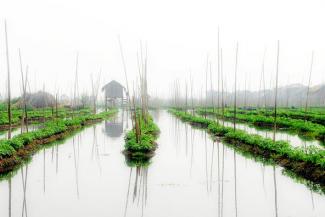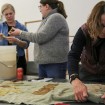Myanmar Opens Doors to UK, Lecturer Dives Into Research and Culture

Welcome to Myanmar, a beautiful, natural resource-rich country located in Southeast Asia. Here, natural beauty is filled with cultural and historical significance. Known as the land of pagodas and host to the world’s oldest and longest teakwood bridge, Burma now acts as a hub for studying, teaching and living.
However, this was not always the case. For most of the county’s existence, Myanmar’s frontiers have been restricted to foreign visitors — due to political circumstances. It wasn’t until recently, after the military junta had dissolved itself for a relatively better establishment, that visitors were officially allowed entry. University of Kentucky Plant Pathology Lecturer Lou Hirsch recently visited the country and considers the move an exceptional opportunity for cultural immersion and research.
Hirsch is a lecturer for both the undergraduate and graduate programs in plant pathology and agricultural and medical tiotechnology, within the College of Agriculture, Food and Environment. He focuses on STEM (science, technology, engineering and mathematics) education and basic molecular biology of plant pathogens, and his interest for the field stems from the backbone of science: curiosity.
“It is interesting to see how organisms interact with each other at such a small microscopic molecular level,” Hirsch explained. His passion for travel and his love for the field have taken Hirsch around the world. For instance, he visited several Asian countries such as Cambodia and Vietnam. After exploring Myanmar last year, he returned to the U.S. with some knowledge of the Burmese agriculture and is eager to go back.
Hirsch’s excitement to return to Myanmar is, really, an arresting testimony of this welcoming and charming country. However, his excitement is not just about touring impressive pagodas or trying a mohinga meal. Rather, he wants to assist the Burmese people with his expertise. One domain Hirsch seeks to help the locals with is, of course, agriculture.
Myanmar, albeit rich in natural resources, is a relatively poor country. About 70 percent of the country’s gross domestic product is based on agriculture, most of which is subsistence farming. One of the most common cultivation practices in Myanmar is the ye-chan, a type of floating farming which is highly practiced on the country’s second largest lake. The system features the cultivation of several hectares of floating lands to produce tomatoes and other vegetables.
According to Hirsch, had the annual yield been significant and consistent, tomato production would have played a more significant role in the growth of the Burmese economy. However, the effort of the Burmese farmers has met much misfortune. Along with limited agricultural infrastructure, the ye-chan suffer from a severe viral disease, and the local farmers do not possess the means to counter the epidemic.
Had there been proper institutions to conduct professional, agriculture-related research in Myanmar, an easier process could have existed to diagnose and treat the disease. The country is, unfortunately, very limited in such resources. The only major agricultural school in Myanmar is Yezin Agricultural University (YAU), but YAU’s expertise is relatively limited, too.
According to Hirsch, one aspect that makes the disease epidemics more severe is that the plant disease management infrastructure in Myanmar is influenced mostly by the chemical companies. Unlike the U.S., there are few public experts to provide a rather unbiased approach toward agricultural advisement. Indeed, the Burmese’ best option is to ask the outside world for help. Yet, since the country only recently opened to the western world, it is relatively difficult for the locals to find assistance from academic professionals. It is, among many other incentives, this situation that motivates Hirsch to go back to Myanmar.
During his visit, Hirsch was exposed to the problem. However, due to language barriers, the locals weren’t able to tell him the name of the disease, much less inform him about it. Nevertheless, Hirsch vows to go back with better equipment not only to diagnose the disease, but to treat it as well. He even plans to mount a program that will allow UK students to visit and explore Myanmar. In addition, he applauds UK’s memorandum with YAU to allow Burmese students to benefit from the UK’s exchange program.
To Hirsch, Myanmar remains largely unexplored. He believes the country is still a great incentive for exploration and research.


